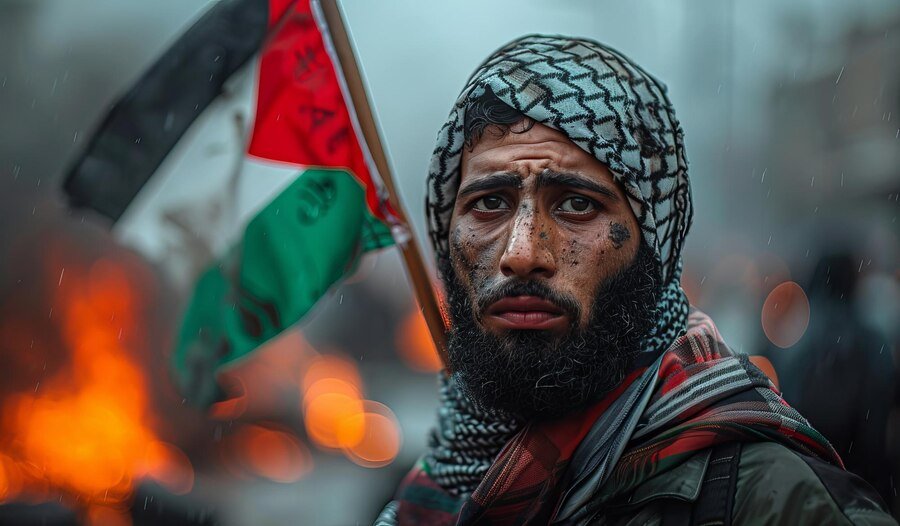The keffiyeh, a seemingly simple piece of fabric, has woven itself into the very fabric of resistance and identity across the Middle East. With its distinctive pattern and rich history, this traditional headdress transcends mere fashion; it tells stories of struggle, resilience, and unity. From bustling markets to global protests, the keffiyeh has become an emblem for those fighting against oppression—reflecting a narrative that is as complex as the region’s tumultuous past. Let’s delve deeper into why the keffiyeh holds such profound significance in both cultural heritage and political discourse.
The history and origins of the keffiyeh
The keffiyeh traces its roots back to ancient Mesopotamia. Originally worn by farmers and shepherds, it served practical purposes. The fabric provided protection from the harsh desert sun and dust storms.
Traditionally, the keffiyeh was made of cotton or wool, often in white or beige colors. Over time, distinctive patterns emerged, with black-and-white checks becoming particularly popular among Palestinian men.
In the mid-20th century, its symbolism began to shift dramatically. During times of political upheaval in Palestine, it evolved into a powerful emblem of identity and resistance.
Prominent leaders like Yasser Arafat helped elevate the keffiyeh’s status on international platforms. As he donned this iconic garment during speeches and appearances, it became synonymous with the struggle for Palestinian rights.
Today, understanding its origins provides valuable context about how this simple cloth transformed into such a potent symbol across cultures worldwide.
Cultural significance of the keffiyeh in the Middle East
The keffiyeh, a traditional Middle Eastern headdress, holds deep cultural significance across the region. This iconic garment is more than just a piece of cloth; it embodies heritage and identity for many.
Originally worn by farmers and Bedouins to shield themselves from harsh desert conditions, the keffiyeh has evolved into a symbol of pride. Its patterns often reflect regional differences, showcasing unique craftsmanship passed down through generations.
In various cultures within the Middle East, donning a keffiyeh can signify solidarity with one’s community or an expression of nationalism. During key historical moments, individuals wore it as a statement against oppression.
Today, the keffiyeh continues to resonate emotionally with people. It serves as an emblem linking past struggles with current aspirations for unity and resistance against injustice in society.
Use of the keffiyeh as a political statement
The keffiyeh transcends mere fabric; it has evolved into a potent political symbol. Initially worn by farmers and Bedouins, its significance changed dramatically in the late 20th century. It came to represent solidarity with Palestinian struggles.
Worn during protests and demonstrations, the keffiyeh embodies defiance against oppression. Activists drape it over their shoulders as they challenge injustices faced by Palestinians. The black-and-white pattern has become synonymous with resistance, uniting people across various movements.
This usage extends beyond geographical borders. From cities around the world to university campuses, wearing a keffiyeh signals an awareness of global issues like colonialism and human rights violations. It’s a silent yet powerful declaration of empathy.
In recent years, artists and musicians have adopted this emblem in their works, further intertwining culture with politics. Through music festivals or art installations, the keffiyeh remains at the forefront of social consciousness.
Role of the keffiyeh in the Palestinian struggle for liberation
The keffiyeh has become an emblem of the Palestinian struggle for liberation. Worn by leaders and activists alike, it symbolizes resilience against oppression.
During protests and acts of civil disobedience, its presence is unmistakable. The black-and-white pattern signifies unity within a diverse movement striving for freedom.
For many Palestinians, donning a keffiyeh transcends mere fashion; it’s an assertion of identity and dignity in the face of adversity. It serves as a reminder of their heritage—a connection to land and culture that remains strong despite displacement.
Moreover, international solidarity movements have embraced the keffiyeh, amplifying its message beyond borders. As people rally around justice for Palestine, this simple piece of fabric becomes a powerful tool in raising awareness about ongoing struggles.
In every fold lies history—stories woven into each thread that narrate years of resistance and hope against all odds.
Controversies surrounding the appropriation and commercialization of the keffiyeh
The keffiyeh has undergone a significant transformation in recent years, evolving from a traditional Arab garment to a global fashion statement. This change often raises eyebrows and sparks debate.
Many argue that the commercialization of the keffiyeh dilutes its cultural significance. When worn by those outside of its original context, it can appear as an act of appropriation rather than appreciation. Some view this trend as disrespecting the struggles associated with the symbol.
Fashion retailers frequently cash in on its aesthetic appeal without acknowledging its deep-rooted meanings. This commodification distances it from its historical ties to resistance and solidarity within Palestinian culture.
Consequently, conversations about authenticity arise. Can something so intertwined with political struggle be effectively transformed into mere apparel? The discourse surrounding these issues is complex and ongoing, reflecting broader societal tensions related to identity and ownership.
Global impact and adoption of the keffiyeh as a symbol of resistance
The keffiyeh has transcended its regional roots to become a global symbol of resistance. Worn by activists worldwide, it represents solidarity against oppression and injustice. Its black-and-white pattern resonates with many who fight for human rights.
Social media plays a significant role in this adoption. Images featuring the keffiyeh are often shared during protests or movements advocating for freedom. This visibility has helped elevate its status beyond fashion into an emblem of activism.
Artists and musicians have also embraced the keffiyeh, using it as a powerful artistic tool that connects various struggles across borders. From street art to music videos, the fabric weaves narratives of resilience.
Moreover, international events marked by conflict have led people from diverse backgrounds to don the keffiyeh, uniting them under a common cause—resistance against tyranny and inequality. The keffiyeh’s journey continues to inspire those who seek justice globally.
The Cultural Significance of the Keffiyeh
The keffiyeh, a traditional Arab headdress, carries profound cultural significance. Originating in the Middle East, it symbolizes not just heritage but also resilience.
Worn predominantly by men, this distinct cloth showcases a rich tapestry of patterns and colors. Each design often reflects regional identities and tribal affiliations.
Beyond its practical use as protection against sun and dust, the keffiyeh embodies unity among various communities. It serves as a reminder of shared history and struggles.
In many parts of the world, wearing the keffiyeh signifies solidarity with Palestinian cause. Its presence at protests amplifies voices fighting for justice.
As it crosses borders and cultures, the keffiyeh invites conversations about identity and resistance while celebrating diversity in expression.
Political and Social Implications
The keffiyeh is more than an accessory; it embodies a rich tapestry of political and social narratives. Originating as a practical garment, its transformation into a symbol of resistance speaks volumes about identity and struggle.
In many Middle Eastern societies, wearing the keffiyeh signifies solidarity with oppressed communities. It acts as a visual reminder of shared history and collective aspirations for justice.
Politically, the keffiyeh transcends borders. Activists across the globe use it in protests to draw attention to various injustices. Its presence at rallies becomes an act of defiance against oppression.
However, this cultural emblem also raises questions about ownership and representation. As fashion trends evolve, some view its commercialization as dilution—an appropriation that risks severing deep-rooted connections to cultural heritage. The delicate balance between celebration and exploitation remains contentious within discussions surrounding this iconic piece of fabric.
Misconceptions and Controversy
The keffiyeh often faces misconceptions that dilute its rich heritage. Many see it merely as a fashion accessory, ignoring its deep cultural roots and historical significance.
Some wearers associate the keffiyeh solely with rebellion or political unrest without understanding its origins in agricultural life. It was once a practical garment for farmers in arid regions, serving to protect against sun and dust.
Controversy also arises over appropriation. When non-Arabs adopt the keffiyeh purely for style, it can feel dismissive of its serious context within Middle Eastern cultures. This has led to tensions about who gets to wear it and why.
Moreover, commercialization can strip away meaning from this powerful symbol of resistance. As brands market the keffiyeh without acknowledging its backstory, they risk trivializing what it represents for countless people around the world.
The Evolution of the Keffiyeh as a Fashion Statement
The keffiyeh has seamlessly transitioned from a traditional Middle Eastern garment to a global fashion icon. Its distinct patterns and versatile styles have captivated fashion enthusiasts worldwide.
Designers often incorporate the keffiyeh into their collections, showcasing its unique aesthetic in high-end runway shows. Streetwear brands have also embraced this trend, creating casual looks that resonate with younger audiences.
Celebrities are frequently spotted wearing the keffiyeh, further cementing its status as a fashionable accessory. This visibility has sparked interest among diverse communities who appreciate its rich heritage while adopting it for personal style.
Despite being rooted in political symbolism, the keffiyeh now finds itself on catwalks and social media feeds alike. It’s fascinating how an emblem of resistance can effortlessly blend into modern wardrobes without losing its cultural essence.
Modern-day Uses and Representation
Today, the keffiyeh transcends its traditional roots. It has woven itself into various aspects of modern culture and fashion. You’ll find it draped over shoulders in urban settings or styled as a chic accessory.
Activists proudly wear the keffiyeh at protests worldwide. It symbolizes solidarity with oppressed communities, particularly in Palestine. Through this garment, they express their beliefs and values.
Fashion designers have also embraced the keffiyeh, incorporating its patterns into haute couture collections. This shift highlights how cultural symbols can evolve while retaining their significance.
Social media platforms amplify these representations further. Many influencers showcase the keffiyeh as a statement piece, sparking conversations on identity and resistance.
Despite commercialization challenges, its core meaning persists—a powerful emblem of resilience against oppression that resonates across borders today.
Conclusion
The keffiyeh is more than just a piece of fabric; it embodies a rich history and deep cultural roots. Its origins can be traced back centuries, serving both practical purposes in the arid climates of the Middle East and evolving into a powerful symbol of identity.
In the heart of Palestinian culture, the keffiyeh holds immense significance. Traditionally worn by men as protection against sun and sand, it has transformed into a mark of solidarity and resistance. As political tensions rose in the region, this simple garment became synonymous with defiance against oppression.
Throughout history, individuals have draped themselves in the keffiyeh to make bold political statements. It has been seen at protests worldwide—from Palestine to global demonstrations for social justice—solidifying its status as an emblem of resilience.
As its narrative intertwined with that of Palestine’s struggle for liberation, the keffiyeh gained popularity beyond its borders. The imagery associated with this iconic scarf resonates deeply within various movements advocating for freedom and rights.
However, not all discussions surrounding the keffiyeh are positive. Its appropriation by fashion brands raises questions about authenticity versus commercialization. The commodification risks diluting its meaning while sparking debates over cultural respect versus exploitation.
Yet despite these controversies, the global impact remains undeniable. From activist gatherings to runway shows, people continue to adopt this symbol across cultures—reminding us that resistance takes many forms.
The evolution from traditional wear to contemporary fashion accessory hasn’t erased its roots but rather embellished them with new layers of meaning. Today’s generation uses it in diverse ways; whether draped around their necks or tied stylishly atop their heads—it signifies unity amidst diversity.
With each thread woven into every keffiyeh comes stories yearning to be told—a reminder that clothing can carry profound narratives far beyond mere aesthetics.







